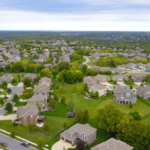Wildfires capture the media attention every year as thousands of acres and homes are burned, and citizens are displaced from their homes and communities. While the bulk of the damage caused by wildfires are out of the control of individual homeowners, precautions can be taken to make homes and communities resilient.
We’ve done the research to bring together the premier wildfire resources from across the web, organized for the first time by region and for specific vulnerable communities like senior citizens, veterans, young children, and the disabled. We hope this resource helps communities become more resilient and rebuild after a catastrophe.
Wildfire Statistics Highlights
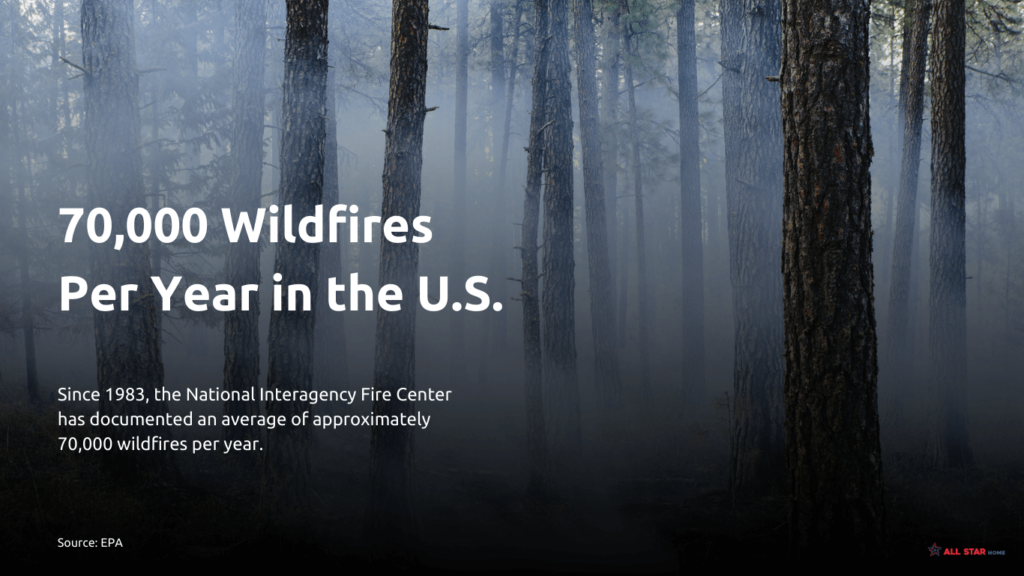
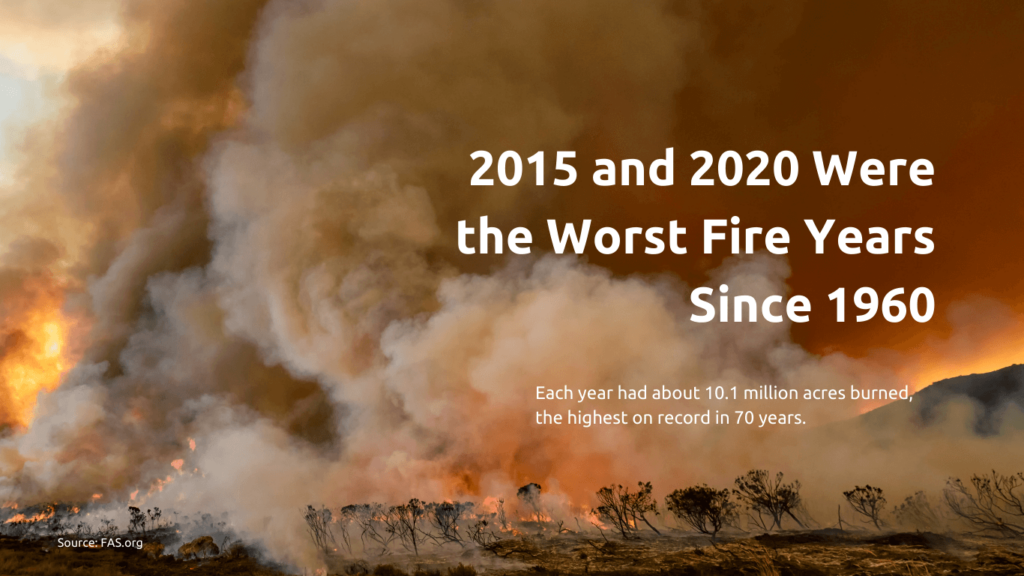
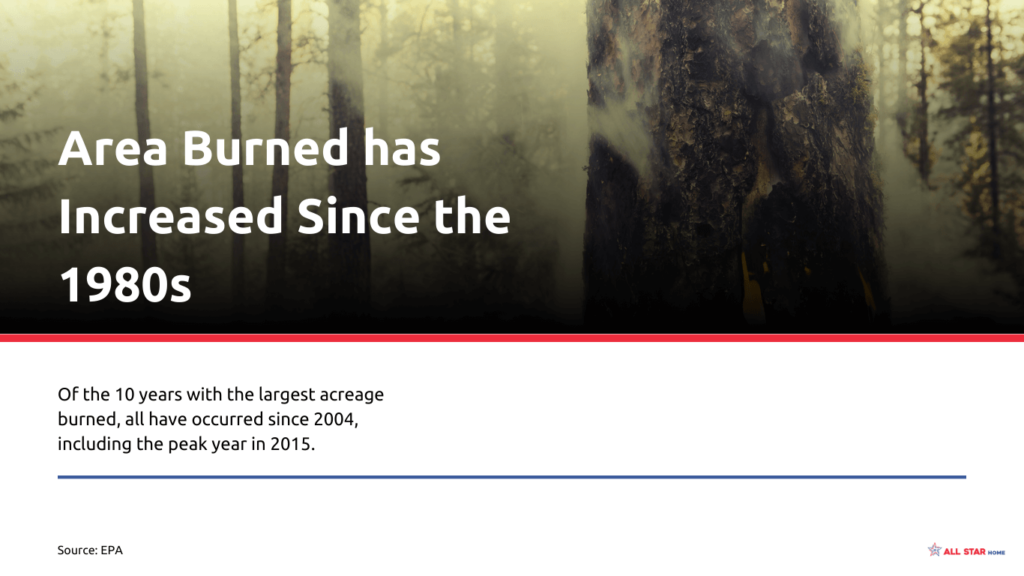
National Wildfire Resources
Many of these resources include high-level maps tracking wildfires, where you can also drill down to your own state and region to better prepare and forecast potential wildfire issues.

InciWeb is your national emergency control room. A live map of all national incidents, with significant wildfires featured prominently. Your first stop if you’re monitoring multiple regions beyond home. Check this before road trips or to track multiple fire events threatening the home.
National Weather Service Wildfire Warnings
The National Weather Service offers up-to-date wildfire warnings and watches to help stay aware of potential dangers in the area. Essential for those in regions prone to wildfires, with necessary information to make decisions regarding safety measures and evacuation plans.
NFPA Wildfire Preparedness Tips
- Detailed infographics and actionable steps that residents can take to protect their homes and surroundings from the threat of wildfires.
- Safety tips that can help you safeguard your home and loved ones from wildfires. From creating defensible spaces to assembling emergency kits, learn how to be ready when wildfire strikes.
- Your home’s immediate surroundings can either fuel a wildfire or help defend against it. Learn practical steps to minimize risk, including clearing leaves, pruning trees, and maintaining a well-hydrated lawn to prevent the fast spread of fires.
Center for Disease Control (CDC) Wildfires Resource
The CDC’s wildfire resource page offers guidance on preparing for, enduring, and recovering from wildfires.
- It highlights the necessity of safeguarding homes and landscapes to mitigate risks and outlines protective measures during wildfire events, including dealing with smoke and power outages.
- The page provides specific resources for those impacted by the Hawaii wildfires, linking to various governmental assistance programs.
- Additionally, it offers health and safety resources for vulnerable groups and health professionals.
- Downloadable social media graphics for wildfire safety promotion are also available.
American Red Cross Wildfire Safety Resources
The Red Cross offers a comprehensive guide to wildfire preparedness, safety, and recovery on their webpage. It encompasses actionable advice on creating evacuation plans, assembling emergency kits, and safeguarding your home, alongside resources for specific groups including children and older adults.
- Educational Resources: The site offers a variety of educational materials, including checklists available in multiple languages and videos to help children understand wildfire preparedness.
- Health and Safety Tips: Detailed guidelines on how to protect yourself from wildfire smoke and how to clean up safely post-wildfire, with a focus on health impacts.
- Support and Relief: Information on the assistance provided by the Red Cross during wildfires, including shelter, food, and comfort, and how to access help during emergencies.
FEMA Wildfire Safety – FEMA’s hub for wildfire preparedness, resources, and grants.
Wildfire Safety Shareable Images & Handouts – with useful reminder visuals for different preparedness levels, ready to be shared on social media or printed.
- Safety First: Precautions to take when returning home, such as checking for smoldering embers and ensuring water and electricity are safe to use.
- Connections FEMA/Ready.gov and other organizations that provide post-wildfire support, including financial aid, counseling, and rebuilding efforts.
Regional Resources
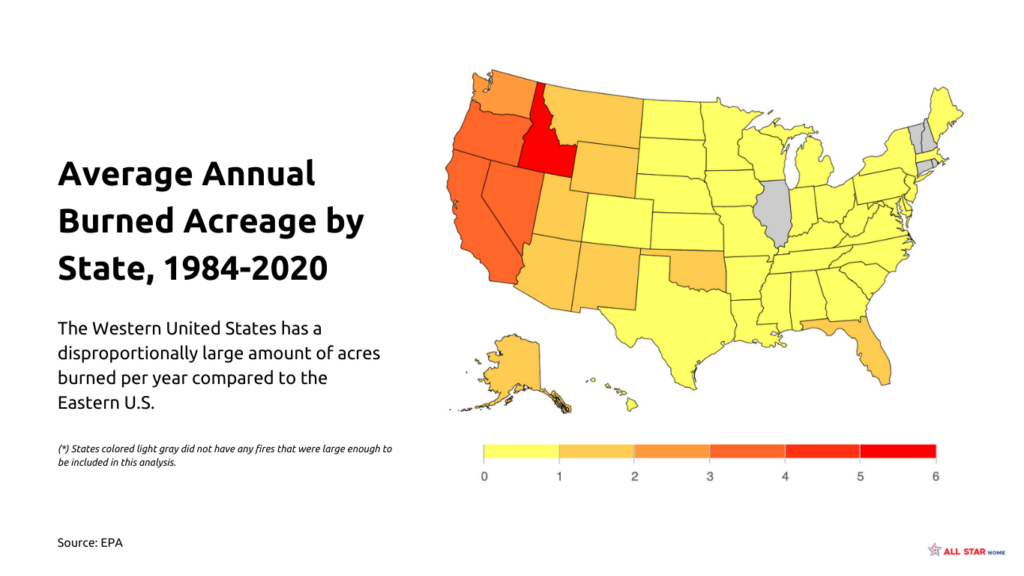
The Western United States
The majority of wildfires happen throughout the western United States. With millions of acres of remote and isolated areas, wildfires are a natural phenomenon and part of healthy ecosystems. The danger happens when fires creep into rural and suburban communities and strike the unprepared.
Comparing the Eastern and Western U.S. wildfire burned area is striking:
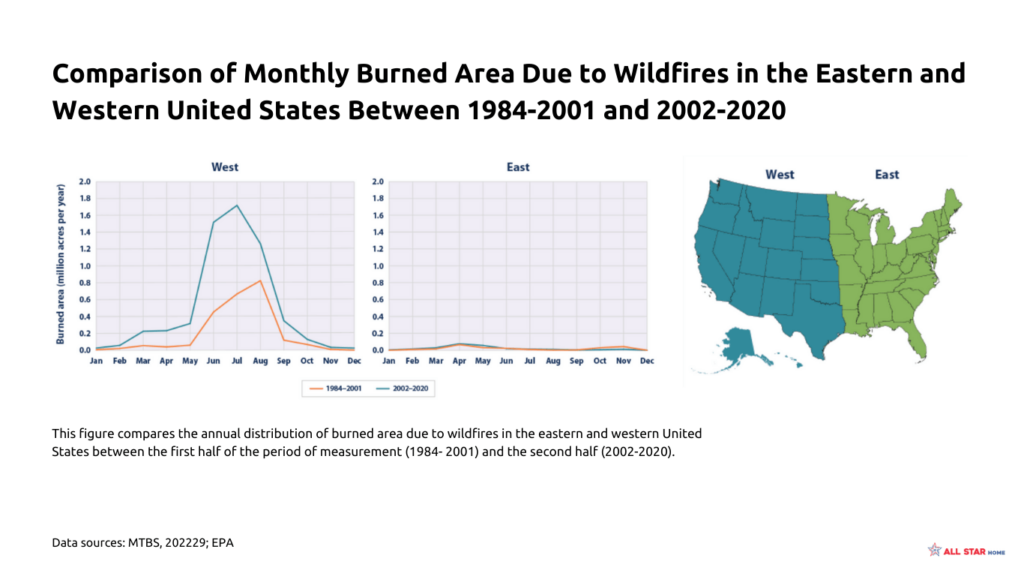
California
As one of the states most impacted by wildfires affecting populations, California leads the charge in resources that are useful for the greater region as well.
- Cal Fire: Current Emergency Incidents – The main resource for all “ongoing emergency responses in California, including all 10+ acre wildfires.”
- CalAlerts – Sign up for emergency alerts to know first when there is danger in your area.
- Ready San Diego – Wildfire preparedness guide useful for anyone living in California and similar climate zones.
Rocky Mountain Region
Rocky Mountain Area Coordination Center – Real time maps of wildfires covering the states of Colorado, Wyoming, South Dakota, Nebraska and Kansas.
The National Interagency Fire Center
The National Interagency Fire Center (NIFC), based in Boise, Idaho, serves as a central hub coordinating national wildfire management efforts in the United States. It integrates resources from various agencies, including federal, state, and local partners, to effectively respond to and manage wildfires across the country.
- For individuals concerned about wildfires, the NIFC provides a crucial service by offering comprehensive information about current wildfire situations, predictive services, and educational resources.
- Its unified approach ensures a well-coordinated, swift, and strategic response to wildfires, thus helping in safeguarding communities and natural resources from the adverse effects of wildfires.
- Use the tools provided by the NIFC to enhance preparedness and understanding of the complex nature of wildfire management.
Southwest
USDA Southwest Wildfire Resources – The hub of wildfire resources for states in the region.
Arizona Interagency Wildfire Prevention – Arizona hub for updates on the wildfires situation throughout the state, as well as preparation advice and emergency information specific to the state.
Southwest Coordination Center – The Southwest Coordination Center (SWCC) is the interagency focal point for coordinating the mobilization of resources between the twelve Federal and State Dispatch Centers of the Southwest Area and, when necessary, the National Coordination Center (NICC) in Boise, ID.
Living with Fire – University of Reno, NV – WF provides resources to homeowners, educators, community groups and firefighting professionals to improve defensible space, ensure homes have proper building materials, manage native and non-native vegetation and prepare for evacuation.
Pacific Northwest
Washington Fire Resources – In collaboration with Washington State University, the hub of wildfire preparation and emergency information in the state.
Oregon Wildfire Response & Recovery – Oregon’s official wildfire response and recovery hub offers critical resources, from real-time fire tracking to recovery assistance, empowering Oregonians to stay safe, informed, and resilient during wildfire seasons.
Hawaii
Our hearts go out to those affected by recent fires in Maui. Once again a reminder of the devastation that can occur from wildfires striking communities that are vulnerable and underprepared.
Hawai‘i Wildfire Recovery and Resilience Resource Guide – Hawaii’s official resource portal provides essential wildfire information, preparation guidelines, and recovery resources to aid residents and communities in navigating the challenges posed by wildfire incidents in the region.
Chamber of Commerce Hawaii Wildfire Resources – The Chamber of Commerce Hawaii provides wildfire resources that cover preparedness tips, what to do during a wildfire, and recovery steps post-wildfire for businesses and families. These resources contain links to trusted websites that provide further information as well as consistent updates during ongoing wildfire disasters.
Eastern United States
The Eastern U.S. sees just a fraction of acres burned every year compared to the West, yet small wildfires can still threaten communities. What’s more, large incidents in Canada can send smoke across borders as we’ve seen this year, so citizens should be prepared for those incidents as well.
Northeastern Forest Fire Protection Compact (NFFPC) – This organization helps citizens in Northeastern United States prepare for wildfires and practice fire safety. It facilitates resource sharing, technology exchange, and mutual aid activities, ensuring effective wildfire management across member states and provinces.
The Bureau of Forest Fire Control and Forestry in Massachusetts – Dedicated to promoting, protecting, and enhancing the health and diversity of both wooded and urban forests across the state.
- They offer a range of programs including grant opportunities for urban forestry, volunteer fire assistance, consulting forestry, and forest stewardship for private lands, alongside overseeing forest health issues and providing regulatory guidance on timber harvests.
- Support and Assistance: Providing aid, assistance, and advice throughout the Commonwealth, including technical and financial assistance to private landowners and municipalities.
North Carolina Wildfire/Emergency Response Situation Report – Up-to-date information on wildfire preparedness and emergencies in North Carolina.
The North Carolina Forest Service’s wildfire situation report page serves as a real-time hub for wildfire data and emergency response updates in the state. It offers daily wildfire reports, current wildfire information, and statistics on fire occurrences, alongside details on out-of-state incidents where NCFS personnel are assisting.
Florida Department of Agriculture and Consumer Services Wildfire Information – A centralized hub for current wildfire information in the state, including active wildfire points, county burn bans, and fire danger indices. It also provides resources on smoke and air quality, evacuation plans, road closures, and national fire maps, along with tips for fire safety and wildfire readiness.
Prepare for the Wildfires: Harden Your Home
Our area of expertise is in home repair and maintenance, so we’ll lead with the importance of improving and retrofitting your home to be wildfire resilient.
The official guide from Ready for Wildfire is a great, authoritative guide to hardening the home. Our summary highlights main takeaways from the post.
In wildfire-prone areas, safeguarding your home involves more than just emergency preparedness; it also means incorporating fire-resistant features into your home’s structure.
Create Defensive Zones
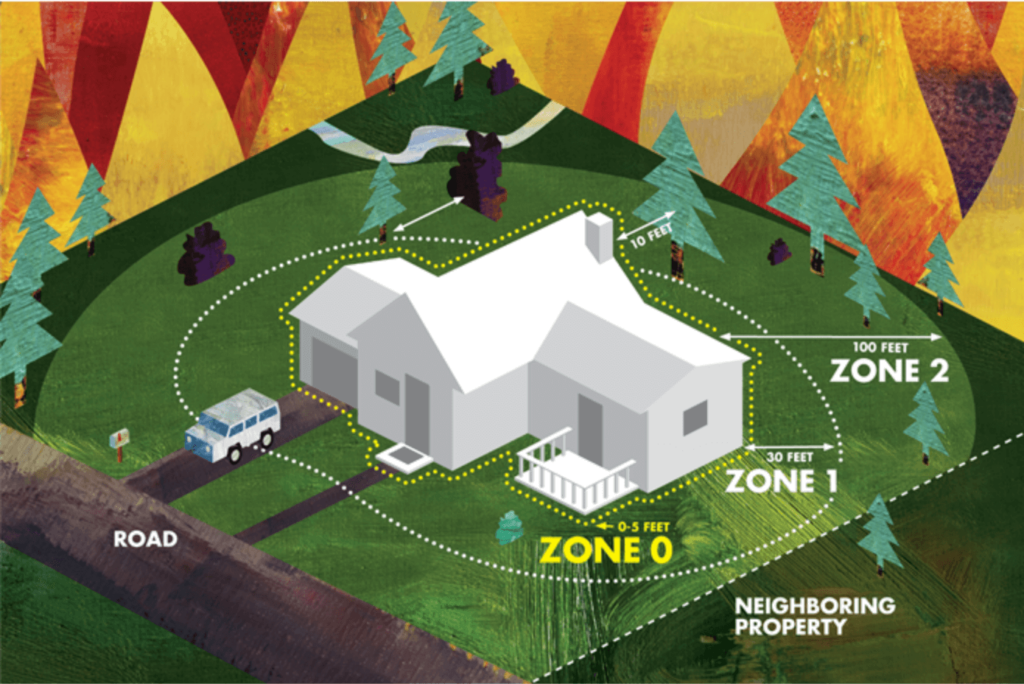
To protect your home during wildfire seasons, creating a defensible space is crucial. This involves implementing specific modifications in the surrounding area to reduce the risk of fire spreading to your property.
- Remove dead vegetation and other flammable materials within 30 feet of your home, including dry leaves, pine needles, and broken branches.
- Maintain a 5-feet non-combustible zone immediately adjacent to your home to prevent fire contact with the structure.
- Install metal or mesh screens on vents and beneath decks to prevent embers from entering your home or becoming trapped.
Here’s a detailed guide to help you fortify your home against wildfires:
1. Roofing
Your roof is the most susceptible part of your home to wildfires, especially if it’s made of wood or shingles. To enhance its resistance:
- Opt for roofing materials like composition, metal, clay, or tile which are less flammable.
- Seal any gaps between the roof decking and covering to prevent ember infiltration.
- Regularly clear your roof of vegetative debris to minimize fire risk.
2. Ventilation
Vents can potentially allow flying embers to enter your home. To safeguard against this:
- Cover all vent openings with metal mesh ranging from 1/16-inch to 1/8-inch. Avoid using plastic or fiberglass mesh as they can melt and ignite.
- Install ember and flame-resistant vents (WUI vents) for added protection.
3. Eaves and Soffits
To prevent embers from catching onto eaves, consider the following:
- Box in eaves using ignition-resistant or non-combustible materials.
- Protect soffits with similar materials to prevent ember entry.
4. Windows
Windows can be vulnerable points during a wildfire. To enhance their resistance:
- Install dual-paned windows with one pane of tempered glass to minimize breakage during a fire.
- Limit the size and number of windows facing large vegetative areas.
- Equip all usable windows with screens to increase ember resistance and reduce radiant heat exposure.
5. Walls
For walls, especially in fire-prone areas, consider these tips:
- Use ignition-resistant building materials such as stucco, fiber cement siding, or fire retardant-treated wood.
- Ensure these materials extend from the foundation to the roof.
- Replace siding in smaller spaces like roof-to-wall areas with non-combustible materials.
6. Decks
To prevent your deck from becoming a fire hazard:
- Use ignition-resistant or approved non-combustible materials for surfaces within 10 feet of the building.
- Establish an ember-resistant zone around and beneath all decks, removing all combustible items.
- If your deck overhangs a slope, maintain a defensible space downslope to prevent flames from reaching the deck’s underside.
7. Rain Gutters
To prevent fire risks associated with rain gutters:
- Regularly clean or enclose them to prevent debris accumulation.
- Install a corrosion-resistant metal drip edge and a non-combustible gutter cover for added protection.
8. Patio Cover
Ensure your patio cover is as resistant as your roof by using similar ignition-resistant materials.
9. Chimney
To prevent chimney fires:
- Cover chimney and stovepipe outlets with non-flammable screens.
- Close the fireplace flue during the fire season when not in use.
10. Garage
Your garage can be a potential fire source. To mitigate this:
- Equip it with a fire extinguisher and tools for fire emergencies.
- Install a battery backup for the garage door and weather stripping to prevent ember entry.
- Store flammable liquids away from ignition sources and treat garage windows and vents as you would those in your home.
11. Fences
To prevent fences from bringing fire to your home:
- Separate your fence from your house or upgrade the last 5 feet to a non-combustible material.
12. Driveways and Access Roads
Ensure easy access for emergency vehicles by:
- Adhering to state and local codes for driveways and access roads.
- Maintaining a minimum of 10 feet clearance on either side for two-way traffic.
- Ensuring gates open inward and are wide enough for emergency vehicles, and keeping overhanging trees and shrubs trimmed.
13. Address Visibility
Ensure your address is clearly visible from the road to assist emergency responders.
14. Water Supply
To aid in fire control:
- Have multiple long garden hoses that can reach all areas of your property.
- Consider installing a pump if you have a pool or well.
- By following this comprehensive guide, you can significantly enhance your home’s resistance to wildfires, safeguarding your property and loved ones.
Teaching Wildfire Preparedness to Children
We’ve all heard Smokey proclaim “Only you can prevent forest fires!”. There are now scores of other resources to prepare children for emergency evacuation during wildfires, as well as other preparedness measures.
- Smokey Bear – This resource offers an interactive platform where children can learn about wildfire prevention through games, activities, and videos featuring the iconic Smokey Bear. It aims to instill a sense of responsibility towards preserving forests and preventing fires from a young age.
- Ready.gov Kids – Ready.gov Kids is a comprehensive resource that provides children, parents, and educators with information and tools to learn about and prepare for emergencies, including wildfires. With a dedicated section for kids, it offers games, quizzes, and educational materials to help children understand the importance of being prepared for various disasters.
- FireSafe Marin – Family Preparedness – This resource is dedicated to teaching children in Marin County, California, about wildfire safety and preparedness. It includes coloring books, puzzles, and activities that engage children in a fun way while imparting critical knowledge about wildfire prevention and safety.
- NFPA – Sparky School House – Offered by the National Fire Protection Association, this resource provides a plethora of educational materials including lesson plans, apps, videos, and games to teach children about fire safety. It is particularly useful for teachers looking to integrate fire safety education into their school curriculum.
- Red Cross – Monster Guard – Monster Guard is an app developed by the Red Cross, specifically designed to teach kids aged 7-11 about preparedness for real-life emergencies, including wildfires, in a gaming environment. It encourages children to become “Monster Guards” and complete various missions that help them learn how to prevent and respond to emergencies.
Senior Citizens & Wildfire Preparedness
As sadly demonstrated by the Maui wildfires, senior citizens can sometimes be left to fend for themselves. While emergency crews ideally will help seniors as a priority, it’s not always the case. Preparedness can save your life.
- CDC – Emergency Preparedness for Older Adults – This comprehensive resource from the CDC is tailor-made for older adults, providing them with guidelines and tools to prepare for various emergencies including wildfires. It helps seniors to create an emergency plan, assemble a kit, and offers tips to stay healthy and informed during crises.
- Ready.gov – Older Adults – Ready.gov offers a specialized section for older adults to help them prepare for emergencies like wildfires. The site gives information on how to make a plan, build a kit, and consider the specific needs that older adults might have during emergencies, such as managing medications and mobility issues.
- Red Cross – Disaster Preparedness for Seniors by Seniors – This is a guide developed by seniors for seniors, offering practical advice and tips to older adults on how to prepare for various emergencies, including wildfires. It covers a range of topics including creating a personal support network and essential items to include in an emergency preparedness kit.
- NIH – Disaster Preparedness for Older Adults This article from the National Institute on Aging at NIH provides tips and resources to assist older adults in preparing for natural disasters and emergencies. It emphasizes planning ahead, being informed, and preparing a disaster supply kit with a focus on the unique needs of senior citizens.
- AARP – Emergency Preparedness – AARP offers this resource that covers the essentials of emergency preparedness for older adults. It provides guidance on how to stay safe during various disasters including wildfires, with a focus on helping seniors maintain communication and secure vital resources during emergencies.
- California Department of Aging (CDA) Services – The CDA services aging citizens in California. This page has information and resources for anyone in the U.S. and similar programs can be found in your state.
- Fire Safe Sonoma – Offers a free wildland fire assessment in conjunction with Habitat for Humanity.
- Habitat for Humanity Aging in Place – A cornerstone program of Habitat for Humanity serving citizens 65+. This program can assist with home repairs after catastrophic events such as wildfires.
Wildfire Resources for Veterans
- California Wildfire Information for Veterans – Resource for veterans affected by past California wildfires.
- VA – Disaster Assistance Programs for Veterans – Resource hub for veterans immediately after a disaster. Connections to different government programs to assist with homelessness and job loss, among other aid.
- Hawaii Wildfires – Veterans Assistance – Special page set up for those veterans affected by recent wildfires in Hawaii.
- VA sets up stations to help veterans impacted by fires – The Veterans Affairs Pacific Islands Health Care System is offering assistance to veterans recently impacted by the Maui fires.
- USDA / U.S. Forest Service Veterans Hiring Program – Program that helps connect veterans with job positions at the USFS, including as wildland firefighters in a 3,000 hr program.
Disabled & Caregivers Wildfire Preparedness
- Ready.gov – Individuals with Disabilities – This resource offers vital information and planning tips for individuals with disabilities and others with access and functional needs to prepare for emergencies, including wildfires. It guides individuals in creating a personal support network and offering a checklist to ensure preparedness for various emergencies.
- FEMA – Office of Disability Integration & Coordination – FEMA’s Office of Disability Integration & Coordination focuses on the inclusion and integration of people with disabilities in all aspects of emergency management. It provides resources and information to ensure that people with disabilities are not left behind during emergencies and that their unique needs are addressed in preparedness plans.
- American Red Cross – Disaster Safety for People with Disabilities – This resource by the Red Cross offers detailed guidelines on how individuals with disabilities can prepare for various emergencies, including wildfires. It provides information on personal assessment, creating a personal support network, and assembling emergency supplies.
- United Spinal Association – Ready to Roll Disaster Preparedness – This resource by the United Spinal Association provides a comprehensive guide for people with spinal cord injuries and disorders to prepare for disasters. It covers aspects such as emergency planning, securing necessary supplies, and safeguarding essential documents.
- CDC – Emergency Preparedness for Individuals with Disabilities – The CDC offers a set of tools and resources aimed at assisting individuals with disabilities in preparing for various emergencies, including wildfires. It includes guides, checklists, and information on how to create an emergency plan that accommodates their specific needs.
Caring for Pets Before and After Wildfires
Sadly, pets are often left behind by owners in a hurry or not able to take care of them and loved ones in an emergency. A smart plan before a wildfire or other emergency can save pets’ lives.
- Ready.gov – Pets and Animals – This official U.S. government website offers a well-rounded guide for preparing your pets and animals for emergencies, including wildfires. It suggests creating a pet emergency kit, making a plan that includes pet-friendly shelters, and recommends specific measures for different types of pets (like microchipping and vaccination).
- ASPCA – Disaster Preparedness – The American Society for the Prevention of Cruelty to Animals (ASPCA) provides a resource-rich section where pet owners can learn how to protect their pets during disasters, including wildfires. It offers a free app for tracking pet records and a checklist for an emergency kit specifically geared towards the needs of pets.
- Humane Society – Disaster Preparedness for Pets – The Humane Society offers a guide for creating a disaster plan that includes your pets. Includes tips on assembling an emergency kit, finding pet-friendly accommodations, and preparing your home for various emergencies, including wildfires.
- AVMA – Pets and Disasters – The American Veterinary Medical Association (AVMA) provides an extensive collection of resources for pet owners to ensure the safety and well-being of their pets during disasters, including wildfires. The site offers checklists, videos, and guidelines to help pet owners prepare, plan, and respond appropriately to emergencies.
- PetMD – How to Prepare Your Pet for a Natural Disaster – This PetMD article offers detailed tips on how to prepare your pets for natural disasters, including wildfires. It includes information on identifying safe places to take your pet, packing a pet emergency kit, and ensuring your pet can be identified and returned to you in case of separation. Great tips for pooches!





